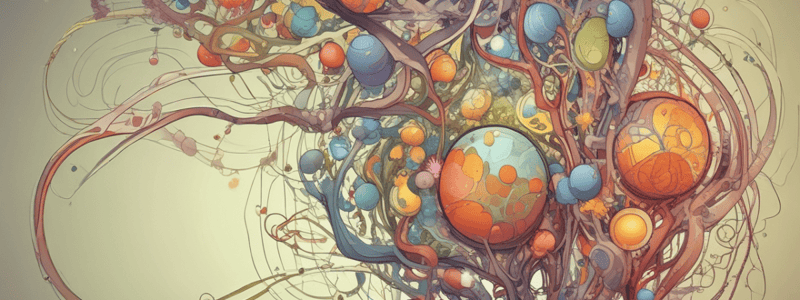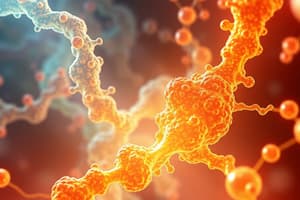Podcast
Questions and Answers
What is the process of breaking down large molecules into smaller ones referred to as?
What is the process of breaking down large molecules into smaller ones referred to as?
- Metabolism
- Catabolism (correct)
- Anabolism
- Synthesis
What is the main source of energy for cells?
What is the main source of energy for cells?
- Fats
- Carbohydrates (correct)
- Nucleic acids
- Proteins
What is the ratio of hydrogen atoms to oxygen atoms in carbohydrates?
What is the ratio of hydrogen atoms to oxygen atoms in carbohydrates?
- 4:1
- 2:1 (correct)
- 1:1
- 3:1
What is the process of building up small molecules into larger ones referred to as?
What is the process of building up small molecules into larger ones referred to as?
What are the smaller molecules formed when complex carbohydrates are broken down?
What are the smaller molecules formed when complex carbohydrates are broken down?
What is the term for the chemical reactions that take place in cells?
What is the term for the chemical reactions that take place in cells?
What type of molecules are formed when many simple sugars join together?
What type of molecules are formed when many simple sugars join together?
What is the most common fat that is stored in the body?
What is the most common fat that is stored in the body?
What is the function of enzymes in metabolism?
What is the function of enzymes in metabolism?
What is the main component of nucleic acids such as RNA and DNA?
What is the main component of nucleic acids such as RNA and DNA?
What is the role of water in metabolism?
What is the role of water in metabolism?
What is the purpose of catalysts in chemical reactions?
What is the purpose of catalysts in chemical reactions?
What type of compounds are formed when two simple sugars join together?
What type of compounds are formed when two simple sugars join together?
What is the function of vitamins in metabolism?
What is the function of vitamins in metabolism?
What is the characteristic shape of proteins due to?
What is the characteristic shape of proteins due to?
What type of compounds are not based on a carbon chain?
What type of compounds are not based on a carbon chain?
what is activation energy
what is activation energy
whats the purpose of a catalyst and why is it useful
whats the purpose of a catalyst and why is it useful
whats the purpose of a catalyst and why is it useful
whats the purpose of a catalyst and why is it useful
what is the name for the molecule on which an enzyme acts
what is the name for the molecule on which an enzyme acts
what is the name for the molecule on which an enzyme acts
what is the name for the molecule on which an enzyme acts
Each enzyme will combine with only one particular substrate and is therefore involved in only one specific reaction. This occurs because the enzyme and its substrate have characteristics that are complementary to one another; that is, the enzyme and the substrate have a shape and a structure that allow them to fit together.
Each enzyme will combine with only one particular substrate and is therefore involved in only one specific reaction. This occurs because the enzyme and its substrate have characteristics that are complementary to one another; that is, the enzyme and the substrate have a shape and a structure that allow them to fit together.
what are the two types types of models that describe how enzymes function
what are the two types types of models that describe how enzymes function
what does the lock and key model state
what does the lock and key model state
what does the induced fit model state
what does the induced fit model state
what does the induced fit model state
what does the induced fit model state
Each enzyme will combine with only one particular substrate and is therefore involved in only one specific reaction. This occurs because the enzyme and its substrate have characteristics that are complementary to one another; that is, the enzyme and the substrate have a shape and a structure that allow them to fit together.
Each enzyme will combine with only one particular substrate and is therefore involved in only one specific reaction. This occurs because the enzyme and its substrate have characteristics that are complementary to one another; that is, the enzyme and the substrate have a shape and a structure that allow them to fit together.
Increasing substrate concentration also increases the rate of the reaction. This occurs because there will be more substrate molecules coming into contact with the enzyme molecules. However, increasing the substrate beyond a certain concentration will cease to have an effect because the active sites on all the enzyme molecules will be fully occupied.
Increasing substrate concentration also increases the rate of the reaction. This occurs because there will be more substrate molecules coming into contact with the enzyme molecules. However, increasing the substrate beyond a certain concentration will cease to have an effect because the active sites on all the enzyme molecules will be fully occupied.
The products of the reaction must be continually removed, otherwise the rate of the reaction will slow because it becomes more difficult for the substrate molecules to make contact with the enzyme molecules.
The products of the reaction must be continually removed, otherwise the rate of the reaction will slow because it becomes more difficult for the substrate molecules to make contact with the enzyme molecules.
Temperature influences enzyme activity. The rate of most chemical reactions increases as temperature increases. This
is true of most enzyme reactions but only within a limited temperature range. Because enzymes are proteins, beyond about 45–50°C their structure changes; they are denatured. As the shape of the enzyme is crucial for its functioning, denatured enzymes are inactive. The temperature at which an enzyme works best is called the optimum temperature. For most enzymes in the human body, this is 30°C to 40°C.
Temperature influences enzyme activity. The rate of most chemical reactions increases as temperature increases. This is true of most enzyme reactions but only within a limited temperature range. Because enzymes are proteins, beyond about 45–50°C their structure changes; they are denatured. As the shape of the enzyme is crucial for its functioning, denatured enzymes are inactive. The temperature at which an enzyme works best is called the optimum temperature. For most enzymes in the human body, this is 30°C to 40°C.
Enzymes are very sensitive to the pH of the medium in which a reaction is taking place. Each enzyme has an optimum pH at which it will work most effectively.
Enzymes are very sensitive to the pH of the medium in which a reaction is taking place. Each enzyme has an optimum pH at which it will work most effectively.
Many enzymes require cofactors. what do they do
Many enzymes require cofactors. what do they do
what are non-protein organic cofactors called
what are non-protein organic cofactors called
what are enzyme inhibitors
what are enzyme inhibitors
Flashcards are hidden until you start studying
Study Notes
Metabolism
- Metabolism refers to all chemical reactions that occur in cells and organisms.
- It consists of two types of chemical reactions: catabolic and anabolic reactions.
- Catabolic reactions involve breaking down large molecules into smaller ones, releasing energy, and are exemplified by digestion.
- Anabolic reactions involve building larger molecules from smaller ones, requiring energy, and are exemplified by protein synthesis.
Organic Compounds
- Organic compounds contain a carbon chain, hydrogen atoms, and may include oxygen, nitrogen, and sulfur atoms.
- Carbohydrates are a major source of energy for cells, containing carbon, hydrogen, and oxygen atoms in a 2:1:1 ratio.
- Simple sugars (monosaccharides) include glucose, fructose, and galactose, which can combine to form disaccharides and polysaccharides (e.g., starch and glycogen).
- Lipids, including fats and oils, are another energy source, broken down to fatty acids and glycerol, which can enter the glycolysis pathway.
- Proteins are composed of amino acids, with enzymes playing a crucial role in controlling metabolic reactions.
Amino Acids and Proteins
- Amino acids contain an amino group and a carboxylic acid group, which react to form a peptide bond when combined.
- There are 20 different amino acids, differing in their side chain structure.
- Proteins are long chains of amino acids, with their type and order determined by DNA code.
- Proteins have a characteristic shape due to chain folding.
Nucleic Acids and Inorganic Compounds
- DNA consists of two chains of nucleotides containing deoxyribose, storing inherited information in the nucleus.
- RNA is a single strand of nucleotides containing ribose, carrying information from DNA to the ribosomes for protein production.
- Inorganic compounds do not contain a carbon chain, with examples including water, minerals, and vitamins.
- Water is essential for metabolism as a fluid for substance dissolution and reaction medium.
- Minerals and vitamins are important for enzyme function, cofactors, and ATP production.
Chemical Reactions and Catalysts
- Chemical reactions require a minimum energy (activation energy) and correct atomic orientation for particles to react.
- Catalysts, such as enzymes, decrease the activation energy, allowing reactions to occur faster without being consumed.
- Enzymes, as biological catalysts, enable chemical reactions to occur at a suitable rate at body temperature.
Studying That Suits You
Use AI to generate personalized quizzes and flashcards to suit your learning preferences.




